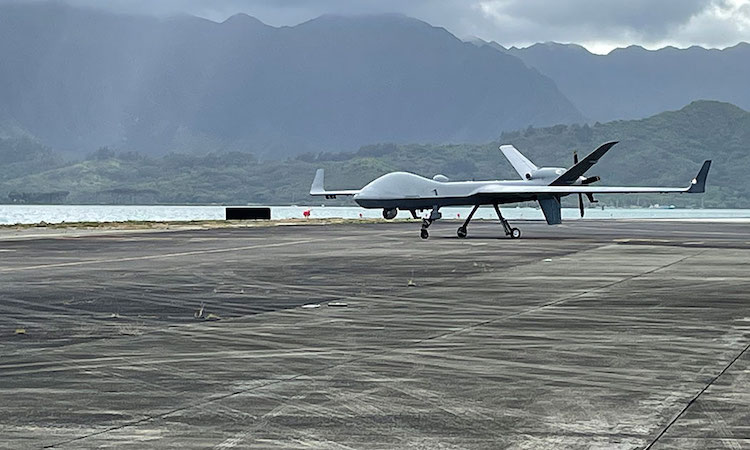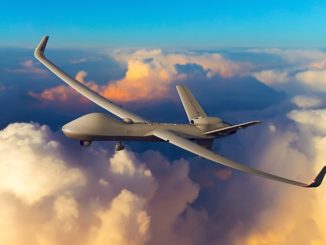
New and current Unmanned Aircraft Systems (UAS) prove ready for new roles and missions in major international naval exercise.
Unmanned aircraft have always contained virtually limitless promise, though sometimes people need to be able to see to believe.
A generation of American troops, their allies and leaders got to know the MQ-1 Predator and MQ-9 Reaper as intelligence and counter-terrorism tools, with important combat air support roles, too. But could these and newer aircraft play a different position in different environments elsewhere?
The answer is a resounding yes – one the U.S. military, its allies and other civil security agencies are expanding rapidly.
Some recent examples included the diverse tasking undertaken by unmanned aircraft systems in support of the international Rim of the Pacific 2022 exercise, known as RIMPAC, the world’s largest event of its kind. Twenty-six nations including New Zealand, more than 25,000 personnel, 38 surface ships and more than 30 unmanned systems all took part in weeks of simulated combat and other operations in the Pacific off Hawaii.
At the centre of it all was the MQ-9 Reaper and its newer sibling, the MQ-9B SeaGuardian, which served as the hub and the spokes of vast, integrated air, surface and subsurface operations.
Unique capabilities
The MQ-9B SeaGuardian can stay aloft longer than any crewed aircraft, giving maritime and defence commanders platforms that can do things they wouldn’t be able to accomplish any other way. With many hours of endurance, the aircraft can search huge sections of ocean, keep track of targets – groups of surface vessels, or submarines – for long periods of time, serve as networking nodes for the battle force and much more.
An MQ-9B SeaGuardian, operated for the U.S. Navy in the exercise by manufacturer General Atomics Aeronautical Systems, Inc., notched a number of first-ever milestones.
Over 15 missions totalling more than 111 flight hours, the aircraft took off and landed automatically over satellite and handled virtually any assignment to support the exercise, assist specific units and handle multiple assignments simultaneously and seamlessly.
The aircraft used its electro- optical infrared sensor to positively identify targets at long range. It used its synthetic aperture radar to feed detailed surveillance to other units. And it used its suite of intelligence and networking equipment to nest deeply within the secure communications and operations of the expansive exercise.
The SeaGuardian hunted for submarines, conducted long-range targeting, collected electronic and signals intelligence, managed radar tracks and more all at the same time, over many hours of long-endurance operation above the ocean.

Advanced sensing, integrated operations
The aircraft’s multiple sensors and other capabilities reinforce each other: it might, for example, detect electronic intelligence suggesting that a distant contact might be present, then cue its radar to search for that ship, which enables it to detect the vessel, and then it can look at the ship with its own electronic eyes and provide full-motion video to its human operators and share data to anyone else who needs it in real time. During RIMPAC, the MQ-9B networked with many nations’ surface ships and aircraft, such as the P-8A Poseidon.
These kinds of capabilities are what make the MQ-9B one of the most in-demand aircraft of its class. The United Kingdom’s Royal Air Force, Japan’s Coast Guard and others are acquiring them to carry out these kinds of missions and many others, including civil surveillance and reconnaissance missions.
New users prize the ability to adapt these aircraft to their specific needs. An aircraft can flex easily from missions over land to those over coastal areas or the open ocean. Or it can flex from supporting naval operations to a real-life open-ocean rescue, as another unmanned aircraft – an MQ-9A Reaper – did during RIMPAC.
These aircraft also can serve as the centrepiece for humanitarian assistance and disaster recovery operations. It can help with the fight against wildfires. It can monitor wildlife and perform important resource protection tasks over broad areas. A nation such as New Zealand could adopt all of these roles and more.
RIMPAC and other exercises have proved again that these aircraft are valuable units on their own, patrolling wide areas of ocean or an important strait, or over land, to provide constant awareness about what’s taking place in the area on or below the surface. Artificial intelligence and machine learning mean that much of this surveillance can take place without human attention, if necessary – but when the aircraft makes a detection, it alerts the users.
SeaGuardian also has the ability to do more than just scan. It can assess if things look unusual: if
two vessels are too close together, for example – which could suggest they’re trans-shipping oil or other contraband – or if a vessel is sailing through an area without broadcasting on the Automatic Identification System, which might suggest it’s trying to evade detection. MQ-9B isn’t fooled.
These aircraft also are invaluable when matched with other units, whether aircraft like the P-8A
or other surface or airborne civil surveillance platforms.
Manned-unmanned teaming
GA-ASI’s extensive experience with manned-unmanned teaming gives it and MQ-9B a huge advantage. The SeaGuardian’s crew work from a ground control station that can be sited anywhere and integrate into the same secure command and control networks as any other unit. The aircraft can be re-tasked as needed or take on unplanned assignments just as any other unit might do.
It also can be additive to many other operations. For example, imagine a crewed maritime patrol aircraft dropped a line of sonobuoys – special sensors that sit under the ocean surface to detect submarines. But that conventional aircraft runs low on fuel and must return to base. MQ-9B could take on the task of monitoring the data from those sonobuoys over a lengthy period, as it handles its other duties. Or MQ- 9B might drop sonobuoys of its own, monitor them and, when it detected a contact, call in a crewed aircraft for further investigation.
All these advantages scale up when more aircraft are available. Working in shifts with several aircraft in a squadron, where one replaces another on a task, or several operating together with others relieving them, maritime commanders obtain constant, real- time, vast domain awareness that isn’t possible in any other way.
The promise afforded by these kinds of operations over multiple domains – open ocean, coastal areas, land and more – is what has prompted the U.S. Marine Corps to add the MQ-9A Reaper as the centrepiece of its strategy for advanced expeditionary basing operations. With a growing fleet of aircraft and a dedicated military occupational specialty devoted to unmanned aircraft operations, the Marines are a great example of a sea service taking advantage of new ways to exploit what UAS have to offer.
As RIMPAC and other military exercises this year have shown, there’s virtually no limit to what the MQ-9 series of aircraft can achieve. Multi-domain and multi-mission capabilities for cross-department and cross-agency employment spanning civil and defence applications appear well suited to the requirements of New Zealand.
With broad geographical areas of interest, a small workforce and limits in other resources, the cost-effective and versatile MQ-9B SeaGuardian has the ability to provide a much- needed solution; and it’s available now.








